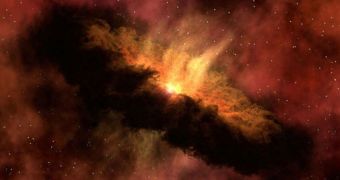Just a few thousands of years after the early Sun appeared from a collapsed cloud of space gas and dust, a protoplanetary disk started forming around it. This structure was made of various types of debris, such as dust that was left after the star ignited. As it was revolving around the new, hot celestial body, the disk was constantly battered with ultraviolet (UV) radiation from the star, as were most of the molecules in it. This was a very dangerous scenario, and all life on our planet may have easily been made impossible right then and there.
However, it would appear that one of the main reasons why life appeared from that chaotic protoplanetary disk was the fact that portions of it were protected by water vapors. According to a new computer model, it appears that these molecules were able to scatter enough UV radiation to allow for what would later become the seeds of the Earth's oceans to endure in the disk, and not get destroyed. In addition, some experts say, these phenomena might have also provided invaluable assistance to the chemicals that are now considered to be the building blocks of biology, Space reports.
“Water is basically capable of sacrificing itself to protect the chemistry below it,” University of Michigan in Ann Arbor expert Ted Bergin says. Together with Thomas Bethell, a colleague also a the UMAA, the scientist developed a model that sought to establish precisely how much water would escape the Sun's radiation if water vapors would permeate the protoplanetary disk. The researchers were surprised to learn that several thousands of oceans' worth of the stuff would endure the damaging effects of UV radiation in this scenario. Details of this investigation appear in a recent issue of the respected scientific journal Science.
The new model could be invaluable to astronomers, as it could help explain why they found water vapors circling inside the protoplanetary disks around young stars elsewhere in the Universe. Planetary scientists say that their field of research could also be further advanced, when considering that the new data could have significant repercussions on how the planets themselves form out of the early disks. “Molecules are fragile. The ultraviolet light can easily break them apart,” Bergin reveals. “Water in the disk provides this nice umbrella,” he adds.

 14 DAY TRIAL //
14 DAY TRIAL //